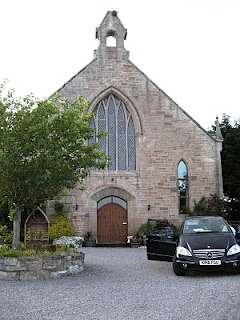Exploring Scotland 1 Castle at a Time, Part 17, The Old Kirk andThe Rodney Stone at Brodie Castle
We stayed in some beautiful unusual places. The Old Kirk was one of them.
It was a traditional Scottish kirk built in 1856 converted into a bed and breakfast. Hillary and Herbie McFarland were our hosts. The McFarlands had retired, moved from Ireland to Scotland and bought the place specifically to run as a bed and breakfast.
It’s a gorgeous place. Its location was just outside Forres in Dyke which is in the Moray area.
It had a very large double sitting room upstairs for the guests so you could relax there if you didn’t want to stay in your room. I’m a night owl so I enjoyed being able to write late at night without disturbing my traveling companion.
Excuse my clutter on the table. I had set up my lap top on the table in the center to work on and was the only one up.
And the stained glass window that took up one whole wall didn't hurt to look at every time I was thinking something through. Talk about great working conditions.
We stayed at the Old Kirk for two nights and used it as our home base to explore the area of Moray.
About a mile from the Old Kirk was Brodie Castle so we decided to make it our first stop our first morning there. And what should I see as soon as we pulled into the drive to the castle A PICTISH SYMBOL STONE!!!

This particular stone is known as the Rodney Stone. It was discovered in 1782 while they were digging the foundation for a new parish church for Dyke and Moy. It has been dated from the 9th century. It was moved to its present location in 1842.
It is named the Rodney stone because it was, at one time, used as a commemorative stone of a victory fought by an Admiral Lord Rodney. Perhaps more appropriately it should have been named after the gravedigger who unearthed it, his name was Rotteney.
There are Druid symbols on this side but a cross on the other. The double disks at the bottom could mean the sun and moon, since the Druids worshiped the sun. Light and Dark, Male and Female, also Life and Death.
Above the discs is an animal. It has been speculated that it could be either a horse or a stag. There was a horse cult near the area but most of the carved horses recovered have had riders. The article in Archaeology that I read said it was too solid to be a Kelpie, the Caledonian equine personification for water. It is more likely a stag because that was a known totem of the more ancient Picts in areas that were highly forested, and at the time this stone was carved the area was covered by forests.
At the top are two sea serpent like mythical creatures gnashing their teeth at one another. It is believed that these represents some kind of upheaval like a flood , an approaching war, some pestilence that invaded the area or some horrible loss.
On the other side is a beautiful Celtic cross.
For both Druid Symbols and Christian Symbols to be carved on one stone, it has been speculated that the person who carved it was conflicted about giving up the old beliefs for the new and were sort of covering all bases during a time of strife. The cross bar of the cross has been defaced at some time, but it is still beautiful.
Along the edge of the stone Ogham has been carved but is very warn. The translation proposed was EDDARNONQ. It is speculated that it may be a name, a spell, or just a boundary mark. It isn't known for certain. Or even what language might have been used, since Scottish Ogham could have a mixture of Old Norse, Gaelic, or Latin mixed in.
Since seeing the stone I've spent hours going over the pictures I took of it. It was one of the highlights of my trip, since druid symbols and Ogham are an important part of my story line for my current work in progress.
Tomorrow I'll talk about Brodie Castle and the history of the Brodies. Having the stone placed here may have brought it exactly where it needed to be. It may have been returned home.
Write on,
Teresa R.
















Comments
Thanks again for your wonderful blog and photos.
The article said it was a class II Pictish stone. With Druidic symbols on one side and the cross on the other.
I'll forward the address of the article that I got my information from . It was published in Archaeology magazine.
Teresa R.
Thanks so much for staying faithful to reading the blog. I would have loved to have gone to Stonehenge. Next time!!!
Teresa R.